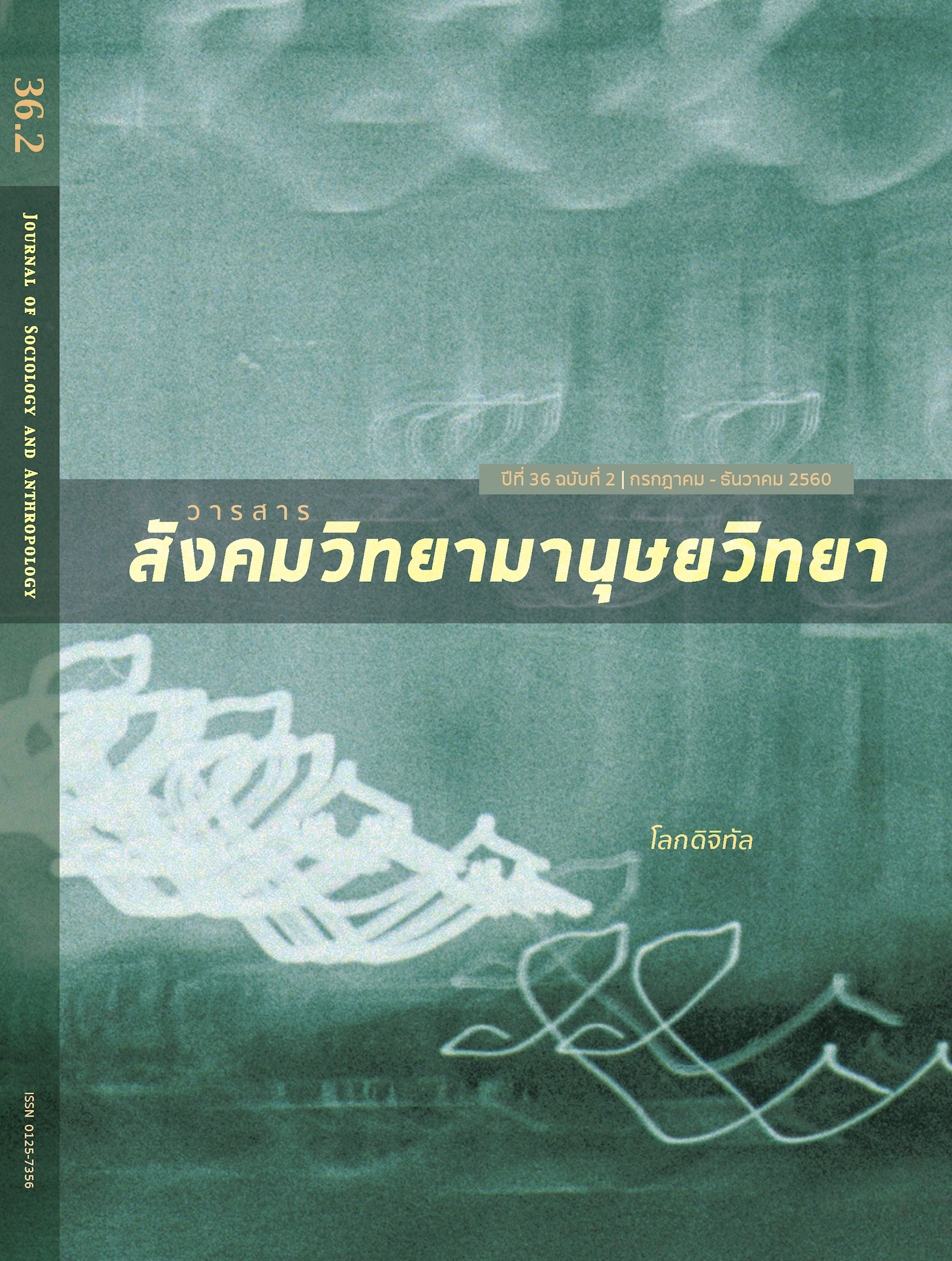“full-time lesurists”: how elderly persons deal with their excessive spare time in “the elderly’s karaoke”
Keywords:
elderly persons, aging culture, spare time, karaoke, digital technologyAbstract
This article looks at how elderly persons deal with their excessive spare time by spending the majority of their daytime at a particular genre of karaoke venues: “the elderly’s karaoke,” which has recently become popular among elderly persons in Bangkok metropolitan areas. The study is based on my observation and interviews with the business owners and customers at two of such the karaoke outlets in Bangkok. I propose that, for elderly persons in industrial societies, going to these karaoke outlets is one of their ways to cope with excessive spare time after retirement. Activities at these karaoke outlets allow them to share experiences with a cohort of similar age and get them connected to their bygone time through “Lukkrung” songs, a popular musical genre among Thailand urban population during the 1950s-1970s. Finally, I suggest that their uses of digital devices in karaoke routines have contributed to transform such a leisure activity to a form of “serious leisure”.
References
จุฑารัตน์ ประเสริฐ. 2557. “พฤติกรรมการใช้แอพพลิเคชั่นไลน์กับการรับรู้ตนเองและการสร้างความสัมพันธ์กับผู้อื่นของผู้สูงอายุไทย.” วิทยานิพนธ์นิเทศศาสตรมหาบัณฑิต (นิเทศศาสตร์), จุฬาลงกรณ์มหาวิทยาลัย.
ฉกาจ ราชบุรี. 2537. “ประวัติศาสตร์ธุรกิจเพลงลูกทุ่งไทย พ.ศ. 2507-2535.” วิทยานิพนธ์ศิลปศาสตรมหาบัณฑิต (ประวัติศาสตร์), มหาวิทยาลัยธรรมศาสตร์.
ปิ่นแก้ว เหลืองอร่ามศรี. 2553. “วัฒนธรรมวัยรุ่น.” สังคมศาสตร์ 22(1): 25-52.
พัฒนา กิติอาษา. 2553. “ดนตรีอีสาน แรงงานอารมณ์ และคนพลัดถิ่น.” ใน ผู้คน ดนตรี ชีวิต เล่ม 2: เสียงของประเทศไทย, บรรณาธิการโดย สุวรรณา เกรียงไกรเพ็ชร์, สรินยา คำเมือง, กมลทิพย์ จ่างกมล, และ อลงกต วรรณวิชัยกุล, 141-223. กรุงเทพฯ: ศูนย์มานุษยวิทยาสิรินธร (องค์การมหาชน).
ยศ สันตสมบัติ. 2540. มนุษย์กับวัฒนธรรม. พิมพ์ครั้งที่ 2 แก้ไขเพิ่มเติม. พิมพ์ซ้ำ, กรุงเทพฯ: สำนักพิมพ์มหาวิทยาลัยธรรมศาสตร์.
วิศปัตย์ ชัยช่วย. 2560. “การใช้ LINE ของผู้สูงอายุ: การศึกษาเชิงปรากฏการณ์วิทยา.” Veridian E-Journal, Silpakorn University สาขามนุษยศาสตร์ สังคมศาสตร์ และศิลปะ 10(1): 905-918.
ศิริพร แซ่ลิ้ม. 2558. “พฤติกรรมการใช้ไลน์แอพพลิเคชั่นของผู้สูงอายุในเขตกรุงเทพมหานคร.” วิทยานิพนธ์วารสารศาสตรมหาบัณฑิต (สื่อสารมวลชน), มหาวิทยาลัยธรรมศาสตร์.
สมสุข หินวิมาน. 2558. ว่างยังวุ่น: ชนชั้น เพศสภาพ และเวลาว่างของผู้หญิง. กรุงเทพฯ: พารากราฟ.
สุจิตต์ วงษ์เทศ. 2538. “เพลงลูกทุ่ง.” ใน เลิศชาย คชยุทธ. ไทยลูกทุ่ง, ไม่ระบุเลขหน้า. กรุงเทพฯ: มติชน.
เอนก นาวิกมูล. 2527. เพลงนอกศตวรรษ. พิมพ์ครั้งที่ 3 แก้ไขเพิ่มเติม. พิมพ์ซ้ำ, กรุงเทพฯ: เมืองโบราณ.
เอกสารภาษาอังกฤษ
Adorno, Theodor. 1991. The Culture Industry: Selected essay on mass culture. edited with an introduction by Jay M. Bernstein. London: Routledge.
Asian Development Bank. 2015. Thailand: Industrialization and economic catch-up. Mandaluyong City, Philippines: Asian Development Bank.
Best, Shaun. 2010. Leisure Studies: Themes and perspectives. London: Sage.
Boontarig, Waransanang, Wichian Chutimaskul, Vithida Chongsuphajaisiddhi, and Borworn Papasratorn. 2012. “Factors Influencing the Thai Elderly Intention to Use Smartphone for e-Health Services.” Proceeding of 2012 IEEE Symposium on Humanities, Science, and Engineering Research, 242-246, Kuala Lumpur, Malaysia, June 24-27.
Elias, Norbert and Eric Dunning. [1986] 2008. Quest for Excitement: Sport and leisure in the civilising process. Revised edition, vol. 7 of The Collected Works of Norbert Elias, edited by Eric Dunning. Dublin: University College Dublin Press, 2006-2014.
Huber, Lesa Lorenzen, Kalpana Shankar, Kelly Caine, Kay Connelly, L. Jean Camp, Beth Ann Walker, and Lisa Borrero. 2013. “How In-Home Technologies Mediate Caregiving Relationships in Later Life.” International Journal of Human-Computer Interaction 29(7): 441-455.
Loe, Meika. 2010. “Doing It My Way: Old women, technology, and wellbeing.” Sociology of Health & Illness 32(2): 319-334.
Long, Susan O. 2012. “Bodies, Technologies, and Aging in Japan: Thinking about old people and their silver products.” Journal of Cross-Cultural Gerontology 27(2): 119-137.
Reddy, Peter, Irundika Dias, Carol Holland, Niyah Campbell, Iaysha Nagar, Luke Connolly, Peter Krustrup, and Harry Hubball. 2017. “Walking Football as Sustainable Exercise for Older Adults–A Pilot Investigation.” European Journal of Sport Science 17(5): 638-645.
Sakdulyatham, Raywadee, Somjaree Preeyanont, Rajalida Lipikorn, and Rewadee Watakakosol. 2017. “User Interface on Smartphone for Elderly Users.” International Journal of Automation and Smart Technology (AUSMT) 7(4): 147-155.
Thompson, Edward Palmer. 1967. “Time, Work-Discipline, and Industrial Capitalism.” Past & Present 38: 56-97.
เอกสารออนไลน์
นิตยสารผู้จัดการ. 2536. “ดิโอลด์สยาม พลาซ่า บทพิสูจน์ฝีมือสยามพาณิชย์ฯ.” นิตยสารผู้จัดการ, พฤษภาคม 2536. http://info.gotomanager.com/news/details.aspx?id=5951. สืบค้นวันที่ 13 ธันวาคม 2560.
วิโรจน์ จุนประทีปทอง. ม.ป.ป. “ประวัติ.” ตั้งฮั่วเส็ง. http://www.tanghuaseng.com/cms_aboutus.html. สืบค้นวันที่ 31 ตุลาคม 2560.
matemate. 2559. “ทำไม ‘ตั้งฮั่วเส็ง’ ห้างสรรพสินค้ายุคดั้งเดิม ยังเติบโตเคียงข้างคนไทยมา 55 ปี.” Brand Inside, 18 ตุลาคม 2559. https://brandinside.asia/tang-hua-seng-department-store. สืบค้นวันที่ 31 ตุลาคม 2560.
Anderson, Monica and Andrew Perrin. 2017. “Tech Adoption Climbs Among Older Adults,” Pew Research Center, May 17, 2017. http://www.pewinternet.org/2017/05/17/tech-adoption-climbs-among-older-adults. Accessed December 5, 2017.
World Bank. 2016. “Thailand Economic Monitor: Aging society and economy–June 2016 (English).” Working Paper No. 107267, World Bank, Bangkok, Thailand. Accessed December 5, 2017. http://documents.worldbank.org/curated/en/830261469638312246/Thailand-economic-monitor-aging-society-and-economy-June-2016.


